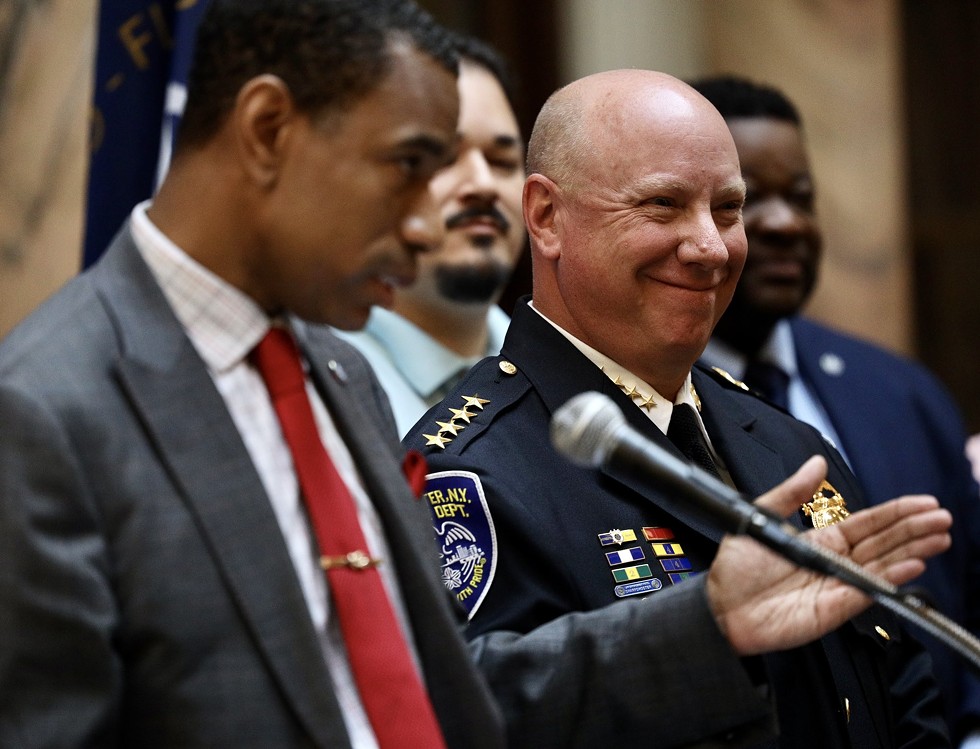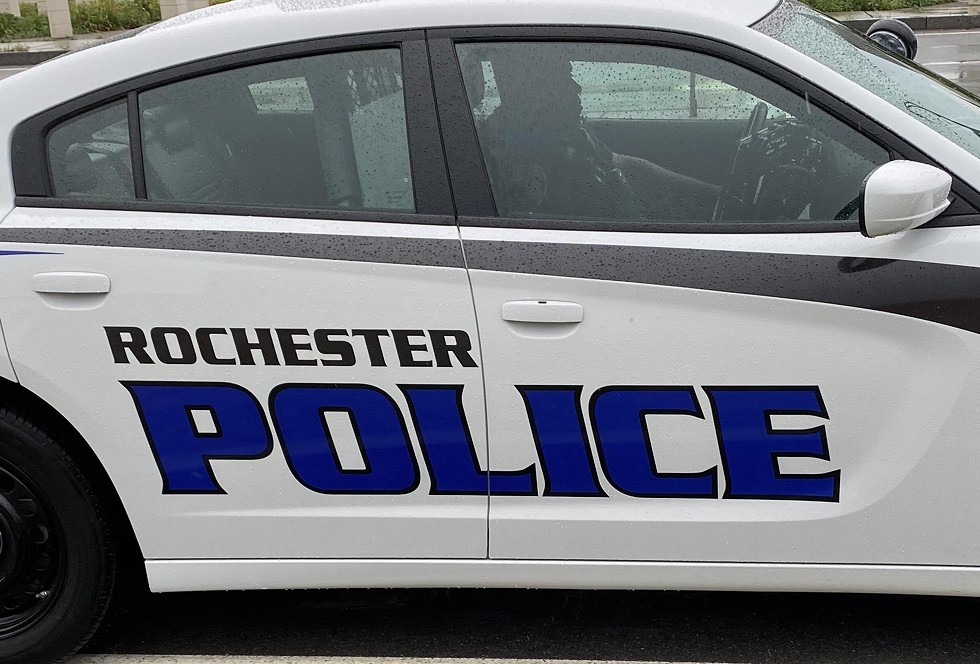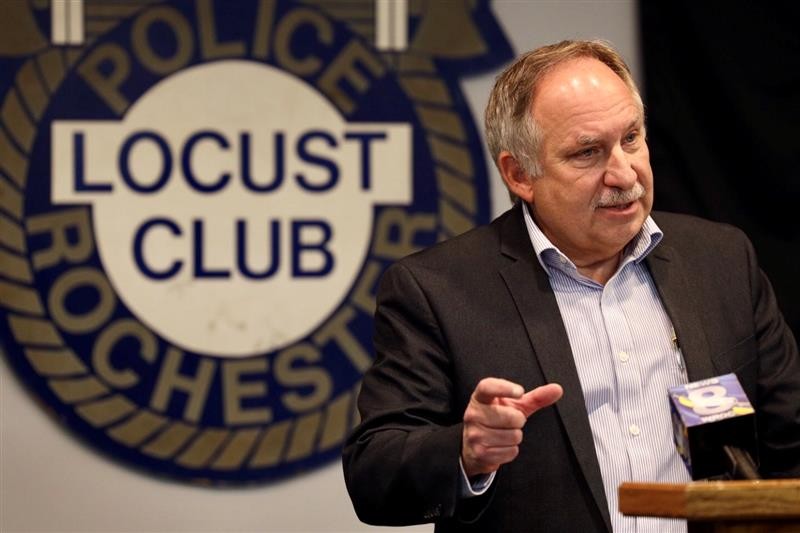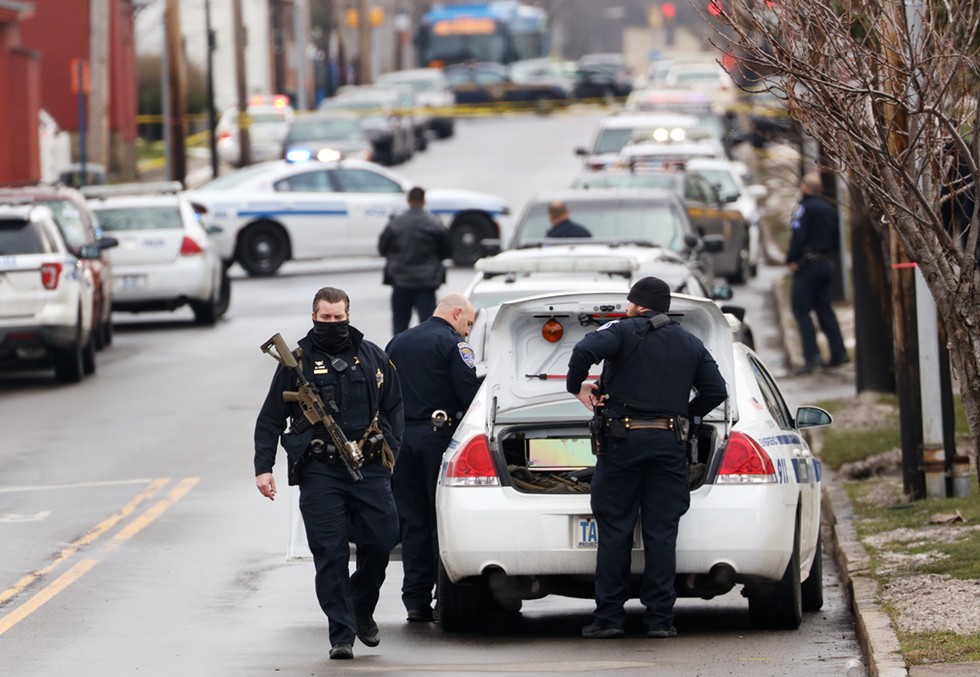On any given day of the week last year, Rochester Police Officer Kevin Sizer put in a full shift as treasurer at the police union hall, then donned his department-issued blues and climbed into a cruiser for another shift patrolling the city.
By the end of any given week, police payroll records show, he logged an average of almost 92 hours on the clock. By the end of the year, he had racked up 2,448 hours of overtime and took home $255,760 in pay.
In doing so, Sizer joined an exclusive Rochester community that is poised to grow: The quarter-million-dollar-cop club.
The officers in the club and those knocking on its door are beneficiaries of a new era in policing in the city, one marked by rising crime, a labor shortage, and seemingly no shortage of opportunities for officers to pad their paychecks and pensions with overtime.
The quarter-million-dollar threshold was crossed two years ago when another officer, Albert Weech, logged 2,483 hours of overtime to triple his salary to $264,929, payroll records show. A third officer, Rickey Harris Jr., is on the cusp of the club. He took home $249,460 last year.
All three officers had base salaries of $86,331 and were among 11 officers who last year eclipsed $200,000 in wages, a figure that until 2020 was so astronomical as to be out of reach for rank-and-file officers.
But six officers last year earned more than $100,000 in overtime pay alone. Scores earned more than $50,000. While about one in five officers logged no overtime in the last fiscal year, those who did earned an average of $20,530, according to payroll records.
“Wow,” said RPD spokesperson Lt. Greg Bello when presented with the data, which was obtained through a Freedom of Information Law request. “I don’t look at the numbers or approve overtime, but damn.”
 By contrast, the two most visible city leaders, Mayor Malik Evans and Police Chief David Smith, are paid salaries of $157,019 and $151,265, respectively, and do not have an option to earn overtime.
By contrast, the two most visible city leaders, Mayor Malik Evans and Police Chief David Smith, are paid salaries of $157,019 and $151,265, respectively, and do not have an option to earn overtime.
NOT A ONE-TIME EXPENSE
A review of police payroll found that the city spent a budget-busting, record-setting $11.8 million on police overtime in the last fiscal year, which concluded at the end of June. That amount represented a 27-percent hike from the previous year and almost doubled overtime costs two years earlier.
The department’s extensive use of overtime is not a one-time expense. There are ancillary costs associated with police officers working beyond their scheduled shifts, some quantifiable and others more anecdotal.
Overtime can add significantly to pension payouts, which are based on a formula that takes into account an officer’s annual take-home pay in their highest three consecutive years of earnings. Officers are eligible for pensions after 20 years.
Weech, for instance, retired from the Rochester Police Department in March after logging three successive years of wages of $210,233, $264,929, and $181,667. During that time, his base salary was $86,331.
Even if the argument can be made that paying overtime is less expensive than hiring new officers, as some police departments around the country grappling with overtime costs have suggested, there are public safety considerations to officers working so many hours.
 A growing body of research shows that long work hours can lead to on-duty fatigue and impaired performance. Studies have linked excessive overtime to small increases in use-of-force incidents and ethics violations, heightened biases, and a surge in complaints against officers.
A growing body of research shows that long work hours can lead to on-duty fatigue and impaired performance. Studies have linked excessive overtime to small increases in use-of-force incidents and ethics violations, heightened biases, and a surge in complaints against officers.
Bello said the department is taking steps to rein in overtime, particularly scaling back on successive double shifts, which he called “unsafe.”
“We’re working towards limits, where someone can’t be working over 16-hour shifts without some sort of approval from above,” Bello said. “So, if somebody works a double, which happens pretty frequently, officers can be forced to work a double, (limiting those) can be a safeguard.”
A study of the Phoenix Police Department compared officers who worked 10-hour shifts with those who worked more than 13 hours. Researchers observed significant increases in reaction time, anticipatory errors, and filings of Professional Standards Bureau grievances among officers who worked the longer shifts.
“This study indicates that there are no apparent advantages but considerable liabilities associated with 13-hour and 20-minute shifts for police officers,” the study read.
Karen Amendola, a chief behavioral scientist with the National Policing Institute whose work delves into the potential public safety issues and health consequences linked to overworked cops, described overuse of overtime as a “rampant problem.”
She said it places officers at risk of short- and long-term health issues, and the public at risk of an exhausted officer making poor decisions.
“(Exhaustion) can not only cost an officer their life, but can also result in a decision with a detrimental effect to the community,” Amendola said.
The situation in Rochester, she said, is playing out in police departments across the country and recalled a similar spike in overtime during the crime wave of the 1990s.
“This is an old story repeating itself,” she said.
Amendola calls for a hard limit of 12 hours for officer shifts. Having witnessed similar scenarios nationwide, she said the burden for solving the matter rests on many shoulders. City leaders have failed to adequately fund a regular staffing model, and unions and chiefs are at fault for allowing officers to work extreme hours, she said.
“You can’t just say, ‘I’m a tough guy, I can get through it,’” Amendola said. “That has been the mentality for a long time of many police departments; macho, tough it out.”
A SHRINKING RPD HEADCOUNT
There are fewer Rochester police officers today than in recent years, mirroring a national trend.
The officer headcount in police departments nationwide fell by 3.5 percent between 2020 and 2022, fueled by hiring cutbacks and sharp increases in resignations and retirements, according to the Police Executive Research Forum, a policy institute in Washington, D.C., that surveys law enforcement agencies around the country.
The decline here outpaces the national trend, but not by much. Last fiscal year, the RPD had a workforce of 705 officers, according to the department’s payroll records. Two years earlier, the headcount was at 751. In May, city officials said there were 68 vacancies in the Police Department.
 Michael Mazzeo, the president of the police union, the Rochester Police Locust Club, blamed the spike in overtime on the administration of Mayor Lovely Warren cutting the police recruiting class in half in 2020 and department brass subsequently failing to adequately address vacancies. The result, he said, has been a scramble to fill open shifts.
Michael Mazzeo, the president of the police union, the Rochester Police Locust Club, blamed the spike in overtime on the administration of Mayor Lovely Warren cutting the police recruiting class in half in 2020 and department brass subsequently failing to adequately address vacancies. The result, he said, has been a scramble to fill open shifts.
“Everybody in every neighborhood of the city should be entitled to know that there is a police officer assigned to where they live,” Mazzeo said. “You talk about stress and supervision, but every boss, on every shift, the first thing they’re doing is calling and scrambling to try and get somebody to come in.”
The Police Department is currently hiring and has an entrance exam slated for Sept. 17. The deadline to apply is Aug. 19. A recruitment poster asks prospective officers “Do You Have What It Takes?” and promises benefits such as generous retirement plans, excellent medical coverage, and a base salary of $83,010 after about four years on the job.
 But payroll records show that only about one in eight officers — typically rookies just a year or two into the job — take home less than that salary.
But payroll records show that only about one in eight officers — typically rookies just a year or two into the job — take home less than that salary.
Indeed, two thirds of the force earned in excess of $100,000 last year, mostly due to working overtime. More than 100 officers cracked $150,000 in take-home pay.
Collectively, Rochester police officers logged 175,540 overtime hours last year, an average of 249 hours, or roughly six weeks, per officer. Two years earlier, officers collectively worked 100,882 hours, or 135 hours apiece, on average.
BUDGET-BUSTING, RECORD-BREAKING
The overtime last year busted the department’s operational budget of $90.8 million, which city officials had trimmed by $4.3 million in response to a year of protests and intense scrutiny on policing practices. Paying for it required restoring more than half of the cut.
In June, the City Council approved emergency legislation that injected an additional $2.3 million into the department. The measure passed by a vote of 6-3.
“A large number of sworn vacancies in the Police Department is responsible for the majority of increased expenditures in addition to the special event and private detail overtime,” the legislation read.
Worth noting is that while the department is spending more on overtime than ever before, the surge in overtime is not at an all-time high.
News outlets in the early 2000s reported that Rochester police were logging upward of 200,000 overtime hours a year when the city was enacting a crime-fighting initiative known at the time as “Zero Tolerance.”
 But wages were lower then, and the force was larger, at about 760 officers. That translated to more officers working overtime than today, but logging fewer hours on average.
But wages were lower then, and the force was larger, at about 760 officers. That translated to more officers working overtime than today, but logging fewer hours on average.
For example, the Democrat and Chronicle in 2008 reported that 55 officers worked 500 or more extra hours that year, the height of the overtime surge in those days. Last year, 117 officers worked 500 or more overtime hours.
By 2010, the city had cut police overtime by about a third, aided by a drop in violent crime and a hiring spree that swelled the Police Department payroll.
When Malik Evans assumed the mayoralty in January, he took the helm of a city whose median annual household income the Census Bureau has pegged at $37,395. Against that backdrop, the quarter-million-dollar cop club caught the new mayor’s eye.
Just a few days into his administration, Evans issued a news release announcing that he had instructed his senior staff to develop a method to provide Rochester police earnings and overtime costs to the public with the context of factors driving those expenses.
The release noted that Evans concluded that the city needed a new method for delivering such information after he examined a think tank’s online database of municipal salaries and discovered that some Rochester police officers were making more than $200,000 a year.
His administration has yet to develop a new approach to conveying the data, but his spokesperson, Barbara Pierce, said doing so remained a priority.
In the news release, however, the mayor appeared to already have a handle on what was fueling the soaring salaries and the implications of them.
“The primary driving factor behind these costs is the amount of overtime we are paying to an understaffed, overworked Police Department whose people are trying to protect and serve a community experiencing incredible levels of violent crime,” Evans said in the release.
“Some of our officers are working more than 80 hours a week,” he went on, “and that’s not good for the officers or the community.”
Gino Fanelli is a CITY staff writer. He can be reached at (585) 775-9692 or [email protected].
By the end of any given week, police payroll records show, he logged an average of almost 92 hours on the clock. By the end of the year, he had racked up 2,448 hours of overtime and took home $255,760 in pay.
In doing so, Sizer joined an exclusive Rochester community that is poised to grow: The quarter-million-dollar-cop club.
The officers in the club and those knocking on its door are beneficiaries of a new era in policing in the city, one marked by rising crime, a labor shortage, and seemingly no shortage of opportunities for officers to pad their paychecks and pensions with overtime.
The quarter-million-dollar threshold was crossed two years ago when another officer, Albert Weech, logged 2,483 hours of overtime to triple his salary to $264,929, payroll records show. A third officer, Rickey Harris Jr., is on the cusp of the club. He took home $249,460 last year.
All three officers had base salaries of $86,331 and were among 11 officers who last year eclipsed $200,000 in wages, a figure that until 2020 was so astronomical as to be out of reach for rank-and-file officers.
But six officers last year earned more than $100,000 in overtime pay alone. Scores earned more than $50,000. While about one in five officers logged no overtime in the last fiscal year, those who did earned an average of $20,530, according to payroll records.
THE TOP 10 HIGHLY-PAID POLICE OFFICERS in FY 2022:
Off. Kevin Sizer: $255,760 (Base Salary: $86,331)
Off. Rickey Harris, Jr.: $249,462 (Base Salary: $86,331)
Inv. Robert O’Shaughnessy: $225,889 (Base Salary: $98,314)
Off. Ted Serinis: $221,332 (Base Salary: $83,010)
Lt. Robert Hill: $219,471 (Base Salary: $111,781)
Off. Angelo Mercone: $216,536 (Base Salary: $86,331)
Off. Kevin Radke: $216,307 (Base Salary: $83,010)
Off. Albert Weech: $210,233 (Base Salary: $86,331)
Capt. Frank Umbrino: 207,245 (Base Salary: $126,132)
Inv. Kevin Leckinger: $207,231 (Base Salary: $96,432)
The take-home pay of some officers was so high compared with previous years that the figures staggered even department representatives.
“Wow,” said RPD spokesperson Lt. Greg Bello when presented with the data, which was obtained through a Freedom of Information Law request. “I don’t look at the numbers or approve overtime, but damn.”

- PHOTO BY MAX SCHULTE
- Mayor Malik Evans introduces Rochester Police Department Chief Dave Smith. The 30-year veteran of the department had been serving as its interim chief before Evans tapped him to be its permanent chief.
NOT A ONE-TIME EXPENSE
A review of police payroll found that the city spent a budget-busting, record-setting $11.8 million on police overtime in the last fiscal year, which concluded at the end of June. That amount represented a 27-percent hike from the previous year and almost doubled overtime costs two years earlier.
The department’s extensive use of overtime is not a one-time expense. There are ancillary costs associated with police officers working beyond their scheduled shifts, some quantifiable and others more anecdotal.
TOTAL OVERTIME COSTS:
FY 2020: $6,848,784
FY 2021: $9,284,458
FY 2022: $11,846,066
Overtime can add significantly to pension payouts, which are based on a formula that takes into account an officer’s annual take-home pay in their highest three consecutive years of earnings. Officers are eligible for pensions after 20 years.
Weech, for instance, retired from the Rochester Police Department in March after logging three successive years of wages of $210,233, $264,929, and $181,667. During that time, his base salary was $86,331.
Even if the argument can be made that paying overtime is less expensive than hiring new officers, as some police departments around the country grappling with overtime costs have suggested, there are public safety considerations to officers working so many hours.

- PHOTO BY JAMES BROWN
- A police officer inside a Rochester Police cruiser.
Bello said the department is taking steps to rein in overtime, particularly scaling back on successive double shifts, which he called “unsafe.”
“We’re working towards limits, where someone can’t be working over 16-hour shifts without some sort of approval from above,” Bello said. “So, if somebody works a double, which happens pretty frequently, officers can be forced to work a double, (limiting those) can be a safeguard.”
A study of the Phoenix Police Department compared officers who worked 10-hour shifts with those who worked more than 13 hours. Researchers observed significant increases in reaction time, anticipatory errors, and filings of Professional Standards Bureau grievances among officers who worked the longer shifts.
“This study indicates that there are no apparent advantages but considerable liabilities associated with 13-hour and 20-minute shifts for police officers,” the study read.
Karen Amendola, a chief behavioral scientist with the National Policing Institute whose work delves into the potential public safety issues and health consequences linked to overworked cops, described overuse of overtime as a “rampant problem.”
She said it places officers at risk of short- and long-term health issues, and the public at risk of an exhausted officer making poor decisions.
“(Exhaustion) can not only cost an officer their life, but can also result in a decision with a detrimental effect to the community,” Amendola said.
TOTAL HOURS OF POLICE OVERTIME:
FY 2020: 100,882
FY 2021: 137,387
FY 2022: 175,540
The situation in Rochester, she said, is playing out in police departments across the country and recalled a similar spike in overtime during the crime wave of the 1990s.
“This is an old story repeating itself,” she said.
Amendola calls for a hard limit of 12 hours for officer shifts. Having witnessed similar scenarios nationwide, she said the burden for solving the matter rests on many shoulders. City leaders have failed to adequately fund a regular staffing model, and unions and chiefs are at fault for allowing officers to work extreme hours, she said.
“You can’t just say, ‘I’m a tough guy, I can get through it,’” Amendola said. “That has been the mentality for a long time of many police departments; macho, tough it out.”
A SHRINKING RPD HEADCOUNT
There are fewer Rochester police officers today than in recent years, mirroring a national trend.
The officer headcount in police departments nationwide fell by 3.5 percent between 2020 and 2022, fueled by hiring cutbacks and sharp increases in resignations and retirements, according to the Police Executive Research Forum, a policy institute in Washington, D.C., that surveys law enforcement agencies around the country.
The decline here outpaces the national trend, but not by much. Last fiscal year, the RPD had a workforce of 705 officers, according to the department’s payroll records. Two years earlier, the headcount was at 751. In May, city officials said there were 68 vacancies in the Police Department.

- PHOTO BY MAX SCHULTE
- Rochester Police Locust Club President Michael Mazzeo speaks to reporters on Sept. 28, 2020, about the appointment of Cynthia Herriott-Sullivan as interim RPD chief.
“Everybody in every neighborhood of the city should be entitled to know that there is a police officer assigned to where they live,” Mazzeo said. “You talk about stress and supervision, but every boss, on every shift, the first thing they’re doing is calling and scrambling to try and get somebody to come in.”
The Police Department is currently hiring and has an entrance exam slated for Sept. 17. The deadline to apply is Aug. 19. A recruitment poster asks prospective officers “Do You Have What It Takes?” and promises benefits such as generous retirement plans, excellent medical coverage, and a base salary of $83,010 after about four years on the job.

- An RPD recruitment poster from 2022.
Indeed, two thirds of the force earned in excess of $100,000 last year, mostly due to working overtime. More than 100 officers cracked $150,000 in take-home pay.
Collectively, Rochester police officers logged 175,540 overtime hours last year, an average of 249 hours, or roughly six weeks, per officer. Two years earlier, officers collectively worked 100,882 hours, or 135 hours apiece, on average.
BUDGET-BUSTING, RECORD-BREAKING
The overtime last year busted the department’s operational budget of $90.8 million, which city officials had trimmed by $4.3 million in response to a year of protests and intense scrutiny on policing practices. Paying for it required restoring more than half of the cut.
In June, the City Council approved emergency legislation that injected an additional $2.3 million into the department. The measure passed by a vote of 6-3.
“A large number of sworn vacancies in the Police Department is responsible for the majority of increased expenditures in addition to the special event and private detail overtime,” the legislation read.
TOTAL RPD PAYROLL:
FY 2020: $77,807,157
FY 2021: $78,002,344
FY 2022: $80,327,125
Worth noting is that while the department is spending more on overtime than ever before, the surge in overtime is not at an all-time high.
News outlets in the early 2000s reported that Rochester police were logging upward of 200,000 overtime hours a year when the city was enacting a crime-fighting initiative known at the time as “Zero Tolerance.”

- PHOTO BY MAX SCHULTE
- Rochester police officers on the scene of where an officer was shot in December 2020.
For example, the Democrat and Chronicle in 2008 reported that 55 officers worked 500 or more extra hours that year, the height of the overtime surge in those days. Last year, 117 officers worked 500 or more overtime hours.
By 2010, the city had cut police overtime by about a third, aided by a drop in violent crime and a hiring spree that swelled the Police Department payroll.
When Malik Evans assumed the mayoralty in January, he took the helm of a city whose median annual household income the Census Bureau has pegged at $37,395. Against that backdrop, the quarter-million-dollar cop club caught the new mayor’s eye.
AVERAGE OVERTIME PAY PER OFFICER:
FY 2020: $9,132
FY 2021: $12,649
FY 2022: $16,827
AVERAGE RPD SALARY (INCLUDING OVERTIME):
FY 2020: $103,596
FY 2021: $106,999
FY 2022: $113,939
Just a few days into his administration, Evans issued a news release announcing that he had instructed his senior staff to develop a method to provide Rochester police earnings and overtime costs to the public with the context of factors driving those expenses.
The release noted that Evans concluded that the city needed a new method for delivering such information after he examined a think tank’s online database of municipal salaries and discovered that some Rochester police officers were making more than $200,000 a year.
His administration has yet to develop a new approach to conveying the data, but his spokesperson, Barbara Pierce, said doing so remained a priority.
In the news release, however, the mayor appeared to already have a handle on what was fueling the soaring salaries and the implications of them.
“The primary driving factor behind these costs is the amount of overtime we are paying to an understaffed, overworked Police Department whose people are trying to protect and serve a community experiencing incredible levels of violent crime,” Evans said in the release.
“Some of our officers are working more than 80 hours a week,” he went on, “and that’s not good for the officers or the community.”
Gino Fanelli is a CITY staff writer. He can be reached at (585) 775-9692 or [email protected].

